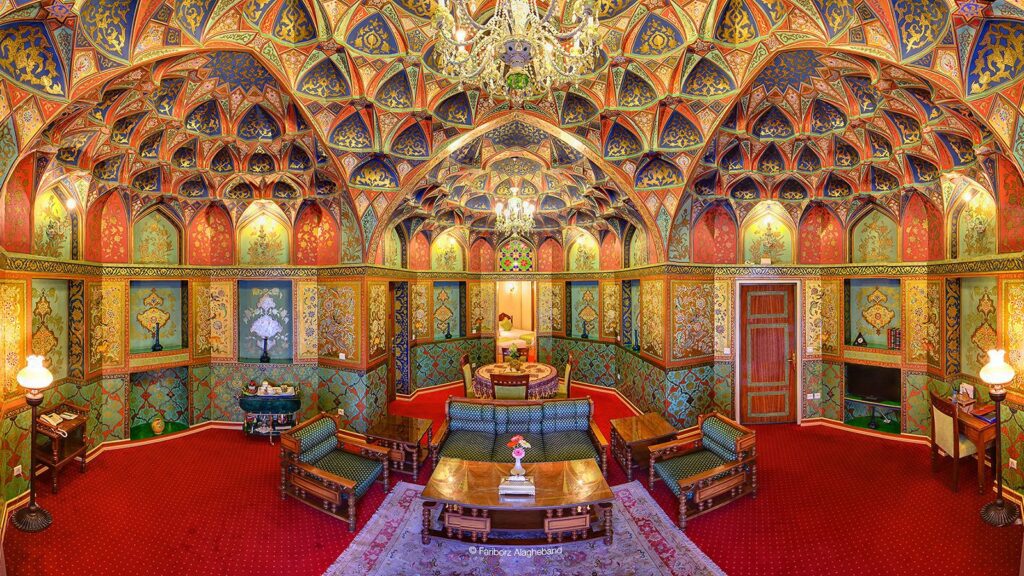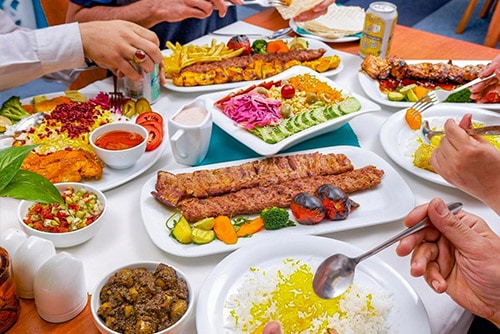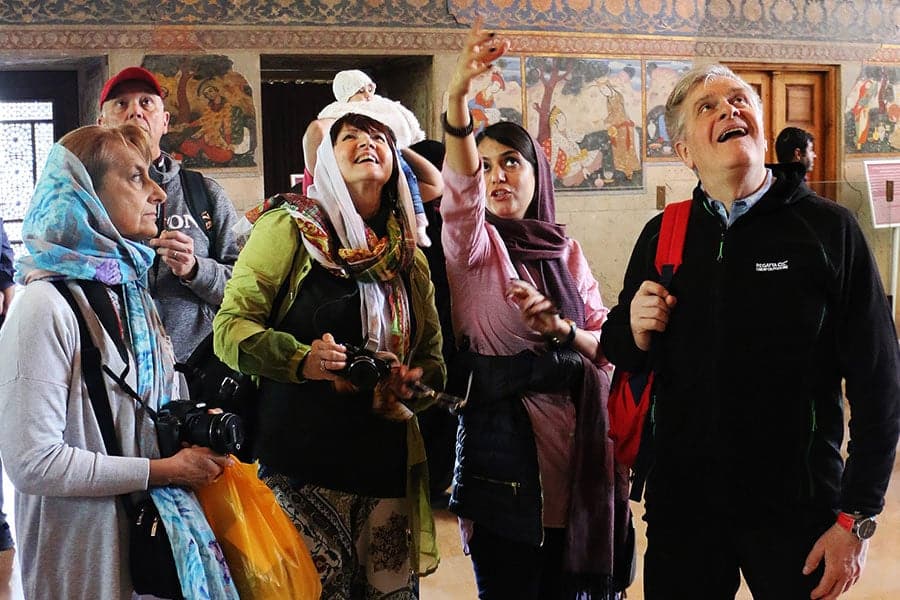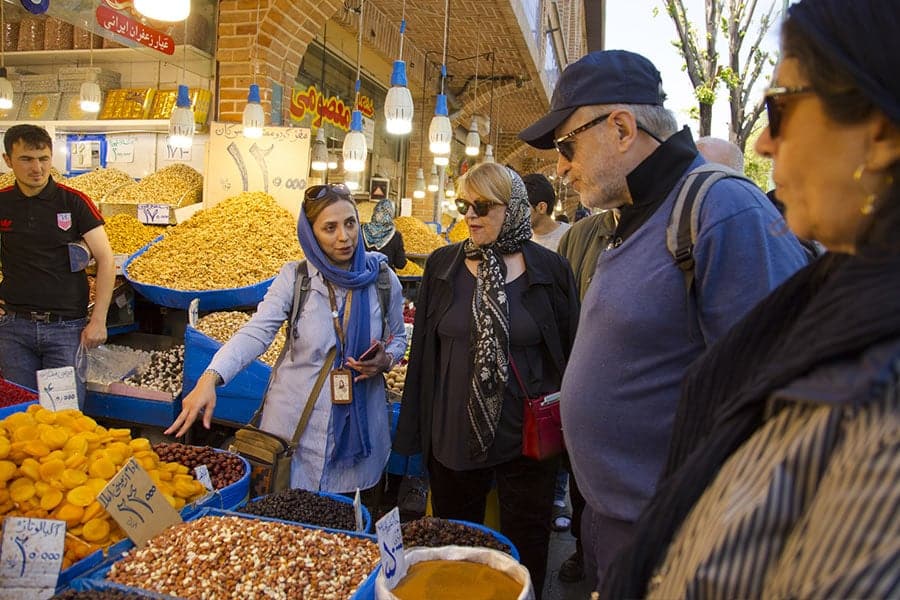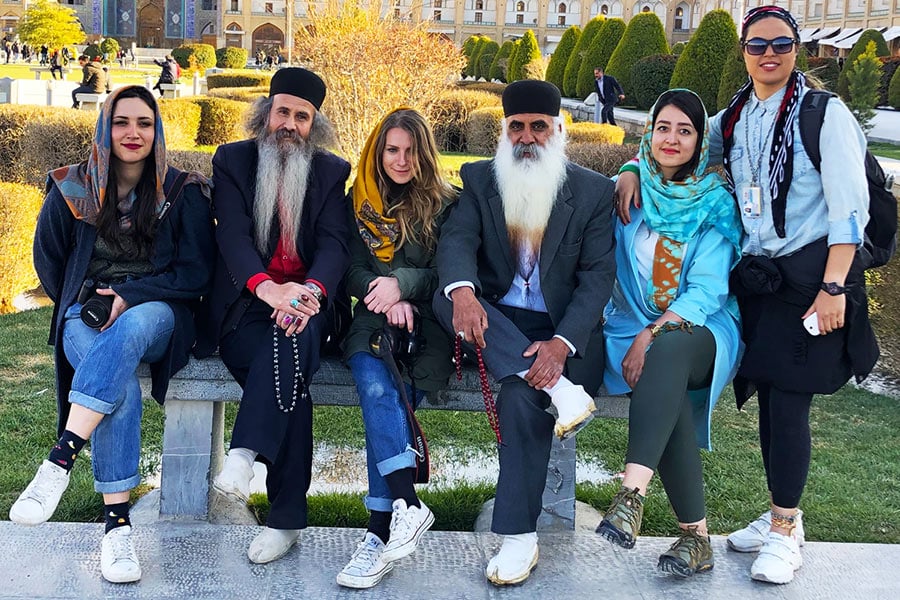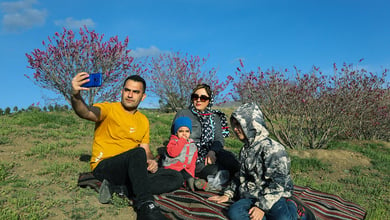Nowruz or Norooz is the first day of the Iranian solar year, corresponding to the first of Farvardin month, marking the celebration of the Iranian New Year and is one of the oldest surviving festivals from ancient Iran.
It has its roots in ancient Iran, and people across vast regions of Asia and other parts of the world celebrate it. Nowruz takes place during the vernal equinox, marking the start of the spring season.
Thursday, March 20, 2025, 12:31 PM
پنجشنبه، ۳۰ اسفند ۱۴۰۳ ساعت ۱۲ و ۳۱ دقیقه ظهر
Contents
Nowruz 2025: Local Times Around the World (Norooz 2025)
Nowruz 2025: Local Times Around the World When It’s 12:31 PM in Tehran
Table below shows what time it will be in various cities around the world at the exact moment when Nowruz, the Iranian New Year or Norooz, starts in Tehran on Friday, March 21, 2025.
| City | Country | Local Time |
|---|---|---|
| Tehran | Iran | Thu, Mar 20, 2025 – 12:31 PM |
| London | United Kingdom | Thu, Mar 20, 2025 – 9:05 AM |
| New York | United States | Thu, Mar 20, 2025 – 5:05 AM |
| Toronto | Canada | Thu, Mar 20, 2025 – 5:05 AM |
| Dubai | United Arab Emirates | Thu, Mar 20, 2025 – 1:05 PM |
| Istanbul | Turkey | Thu, Mar 20, 2025 – 12:05 PM |
| Melbourne | Australia | Thu, Mar 20, 2025 – 8:05 PM |
| Stockholm | Sweden | Thu, Mar 20, 2025 – 10:05 AM |
| Brussels | Belgium | Thu, Mar 20, 2025 – 10:05 AM |
| Beijing | China | Thu, Mar 20, 2025 – 5:05 PM |
| Chicago | United States | Thu, Mar 20, 2025 – 4:05 AM |
| Los Angeles | United States | Thu, Mar 20, 2025 – 2:05 AM |
| Calgary | Canada | Thu, Mar 20, 2025 – 3:05 AM |
| Tashkent | Uzbekistan | Thu, Mar 20, 2025 – 2:05 PM |
| Dushanbe | Tajikistan | Thu, Mar 20, 2025 – 2:05 PM |
| Nur-Sultan | Kazakhstan | Thu, Mar 20, 2025 – 2:05 PM |
| Baku | Azerbaijan | Thu, Mar 20, 2025 – 1:05 PM |
| Xinjiang | China | Thu, Mar 20, 2025 – 3:05 PM |
| Bishkek | Kyrgyzstan | Thu, Mar 20, 2025 – 3:05 PM |
| Ashgabat | Turkmenistan | Thu, Mar 20, 2025 – 2:05 PM |
| Tirana | Albania | Thu, Mar 20, 2025 – 10:05 AM |
| Tbilisi | Georgia | Thu, Mar 20, 2025 – 1:05 PM |
| Baghdad | Iraq | Thu, Mar 20, 2025 – 12:05 PM |
| Damascus | Syria | Thu, Mar 20, 2025 – 12:05 PM |
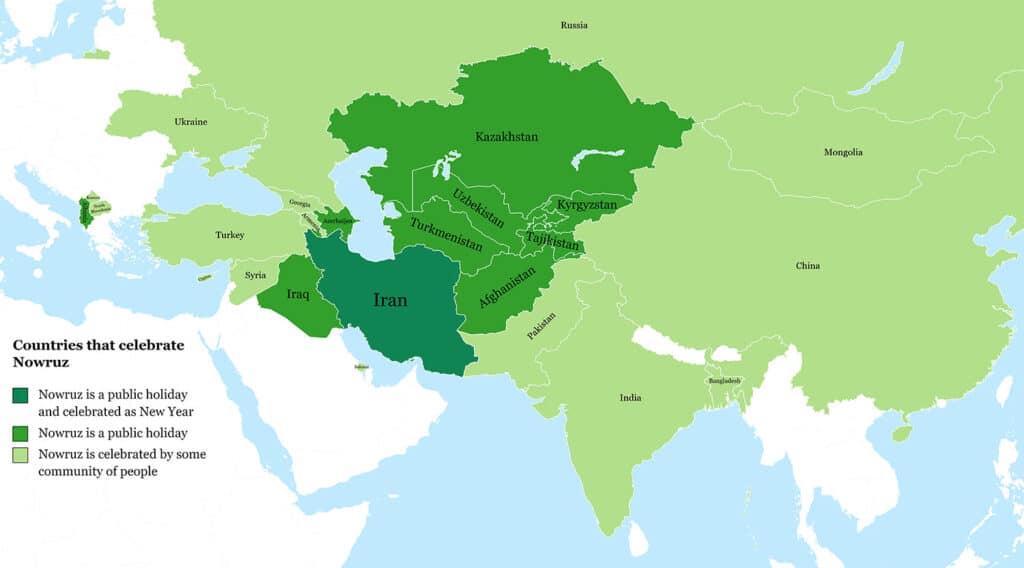
People in Iran and Afghanistan consider Nowruz (Norooz) as the start of the New Year. In several other countries, namely Tajikistan, Russia, Kyrgyzstan, Kazakhstan, Syria, Iraq, Georgia, the Republic of Azerbaijan, Albania, China, Turkmenistan, India, Pakistan, and Uzbekistan, it’s an official holiday, and the people celebrate it.
For a deeper dive into Nowruz celebrations worldwide, We invite you to explore our article on Nowruz Festivities Around the World: Countries and Cultures.
Various ethnic groups in the region have inherited Nowruz, an ancient and traditional festival. It has adopted a distinctive Iranian identity and serves as a symbol that connects individuals and Iranian ethnic groups to the nation of Iran.
Iranians see Nowruz (Norooz) as the herald of nature’s rejuvenation, a time of growth and birth for gardens and orchards. They believe that during Nowruz, in sync with nature, they should start a new phase in fresh attire and with a renewed spirit and perspective.
UNESCO has registered Nowruz, officially titled “International Nowruz Day,” as a cultural and spiritual heritage of humanity. Additionally, this day holds significance as one of the sacred days and religious holidays for Zoroastrians.
For over two millennia, Iran’s history has been marked by a series of significant changes and upheavals.
This land once trembled beneath the hooves of Alexander the Great’s forces, yet it resiliently reclaimed its ancestral customs. Approximately 1,400 years ago, it withstood invasions by Arab Muslims. Despite a subsequent silence that endured for two centuries, it tenaciously maintained its essence. The Mongol onslaughts later tested the Iranian resolve and identity yet again.
Throughout its storied existence, Iran has perennially emerged from its adversities, sovereign and unyielding, akin to a phoenix arising resplendent from the smoldering remnants of its bygone eras.
Amid such unflagging turmoil and transformation, one might ponder the wellspring of vitality and continuity in Iranian culture and civilization.
The keystone of this endurance, arguably, is encapsulated in a single term: Nowruz.
Nowruz, a venerable festivity, epitomizes the enduring spirit of Iranian culture, standing not just as a cherished ritual but also as a beacon of national rejuvenation and solidarity.
As the new year dawns, we are inspired by the eternal wisdom of the 13th-century Persian poet, Rumi, to echo a sentiment that transcends the impositions of states upon individuals: “Say not all are fighting, what use is my lone call for peace? You’re not one, but thousands; light your beacon”.
Happy Nowruz.
When is Nowruz?
The Nowruz celebration begins at the exact moment of the vernal equinox, the instant when the sun, in its apparent path, crosses the Earth’s equator at the beginning of Aries and day and night are of equal length.
In the solar Hijri calendar, the moment of the New Year determines the first day of Farvardin month. If the New Year starts before noon and in the first half of the day, that day is Nowruz; if it starts after noon, the next day is Nowruz.
In the Gregorian calendar, Nowruz mostly corresponds to March 21, occasionally March 20, and rarely March 22.
In countries such as Iran and Afghanistan, which follow the solar Hijri calendar, Nowruz marks the first day of the New Year. However, in Central Asian and Caucasian countries where the Gregorian calendar is more prevalent, Nowruz is celebrated as the beginning of the spring season and is not regarded as the start of the New Year.
The Term “Nowruz”
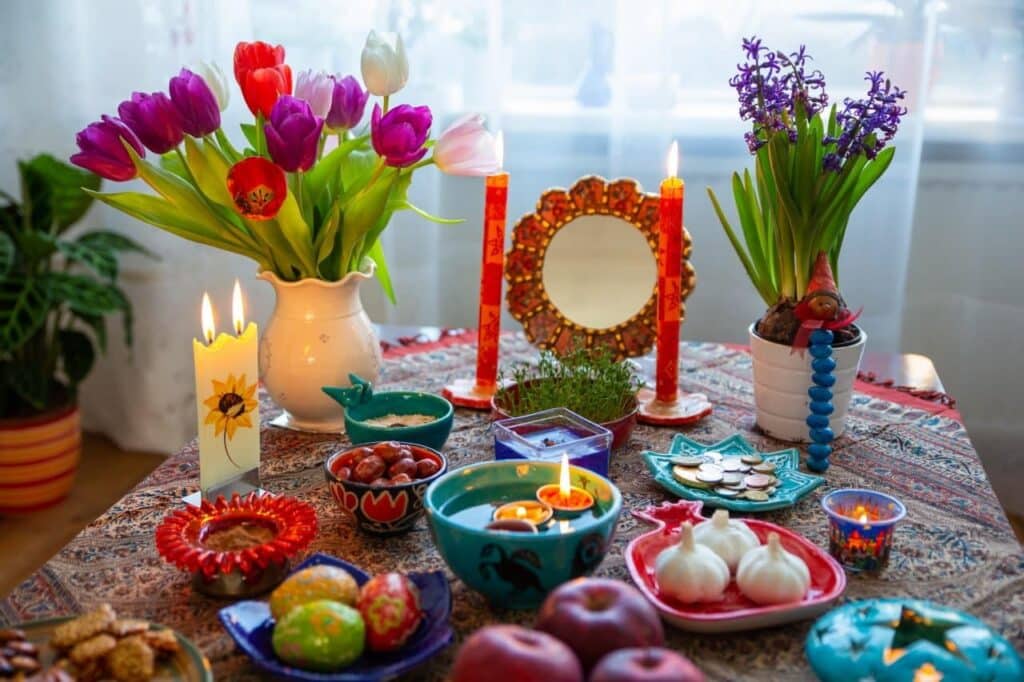
Nowruz holds a significant place in the Iranian calendar, signifying the New Year and the start of spring. This understanding has persisted from ancient lexicons to the present day. This festival has a close connection with Iranian culture and history. Additionally, in other parts of Central Asia, a similar celebration takes place under various names and pronunciations.
The word “Nowruz” originates from the Avestan language, and Avestan historians have documented its equivalent as “navaka raocah.” Throughout history, this term has been expressed and pronounced in various forms, including “No,” “Now,” “Nov,” “New,” and “Naw” for the first part, and “Ruz,” “Rooz,” and “Rouz” for the second part.
History of Nowruz (Norooz)
We do not have precise knowledge of the exact origin and inception of Nowruz. Some historical accounts attribute the beginning of Nowruz to the Babylonians. According to these accounts, the popularization of Nowruz in Iran dates back to 538 BC, specifically the time when Cyrus the Great invaded Babylon.
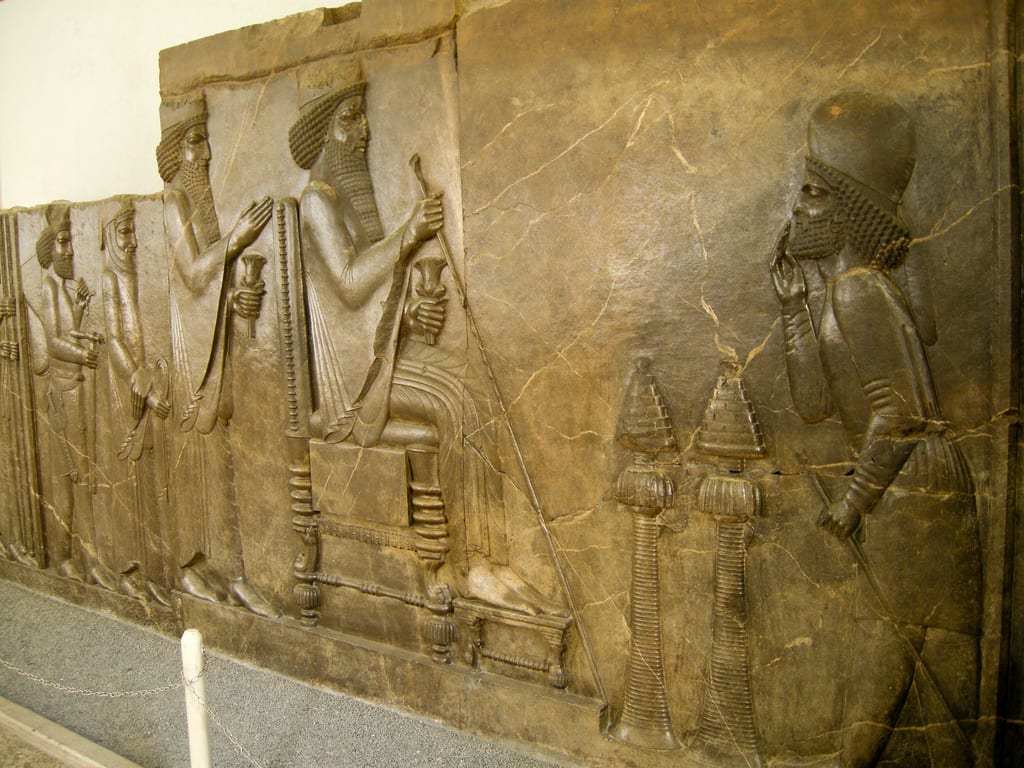
The Babylonians celebrated the first day of the year (generally around the vernal equinox, corresponding to March 21st) marking nature’s awakening. Records suggest that this celebration was recognized almost from 2340 BC.
Mary Boyce, a British Iranologist, believes that ancient Iranians, based on the Mithraic ritual, had held significant celebrations like the spring and autumn (Mehregan) festivals.
However, the splendor of the Babylonian spring festival might have inspired the Iranians to celebrate the New Year during these times.
The New Year’s festival in Mesopotamia (Babylon and Assyria) and also in Elam fundamentally celebrated the resurrection of a deity believed to die and be reborn annually. His death represented the death of the vegetative world, and his resurrection symbolized the rejuvenation of plant life.
Moreover, in some accounts, Zoroaster is mentioned as the founder of Nowruz.
Nowruz In Myths
There is a bas-relief in Persepolis that symbolizes the Zoroastrian Nowruz. On the first day of Nowruz, during the vernal equinox, the power and strength of the lion and the bull are equal in combat. The lion symbolizes the god Mithra or the sun, and the bull represents the earth.

In certain ancient Iranian texts, such as Ferdowsi’s Shahnameh and Tabari’s history, Jamshid is credited as the founder of Nowruz (Norooz). However, in other texts, Keyumars is also mentioned as its founder.
Nowruz (Norooz) During the Achaemenid Era
In the inscriptions left from the Achaemenid period, there is no direct mention of the celebration of Nowruz. However, studies of these inscriptions suggest that the Achaemenids were familiar with Nowruz (Norooz) celebrations.

Some believe that Cyrus the Great declared Nowruz as a national celebration in 538 BC. On this day, he had plans for promoting soldiers, cleaning public places and private homes, and pardoning convicts.
Based on this assumption, these ceremonies continued during the reigns of other Achaemenid kings and were held between 21st of Esfand and 19th of Ordibehesht (roughly corresponding to mid-March to early May).

It is said that during the reign of Darius I, grand Nowruz ceremonies were held in Persepolis. Darius the First of the Achaemenid dynasty minted a gold coin on which a soldier shooting an arrow is depicted, believed to commemorate the Nowruz of 416 BC.
Some researchers believe that Persepolis was built to conduct Nowruz ceremonies.
Nowruz During the Parthian and Sassanid
During the Parthian and Sassanid Periods During the times of the Parthians and Sassanids, Nowruz (Norooz) was also held in high esteem. During this period, numerous celebrations were held throughout the year, with the most important being Nowruz and Mehregan. The Nowruz celebration during the Sassanid era lasted several days (at least six days) and was divided into two periods: the lesser Nowruz and the greater Nowruz. The lesser Nowruz, or the public’s Nowruz, was celebrated for five days, from the first to the fifth of Farvardin. On the sixth day of Farvardin (Khordad Day), the grand Nowruz celebration, or the special Nowruz, took place.
During the Sassanid era, 25 days before the onset of spring, various grains and pulses (rice, wheat, barley, chickpeas, millet, and beans) were planted on twelve columns made of raw bricks. They would keep these plants until the sixteenth day of Farvardin. The more fertile among these plants indicated better yields for the year. It was also common during this period for people to splash water on each other on the morning of Nowruz. Starting from the time of Hormizd I, it became customary for people to light fires on Nowruz night. Also, from the time of Hormizd II, giving coins during Nowruz as gifts became a tradition.

Nowruz After Islam
After the Advent of Islam of all the celebrations that were forgotten in Iran after the advent of Islam due to the negligence of rulers and the opposition of Islamists, Nowruz managed to maintain its status as a national festival in Iran.
The enduring presence of Nowruz in Iranian culture is deeply linked to the country’s traditions, its history, and the cultural memory of its people.
It is said that the Arab conquerors of Iran captured the Sassanid capital on Nowruz. After this, they imposed heavy taxes on the celebration of both Nowruz and Mehregan.
Caliphs of the Umayyad and Abbasid dynasties continued this practice, although later they themselves participated in the Nowruz celebrations and honored it.

There’s no evidence of Nowruz celebrations during the Umayyad era. During the Abbasid period, according to Tabari’s history, the caliph Mu’tazid warned the people of Baghdad against lighting fires on Nowruz and throwing water on passers-by, but he later revoked his order fearing public unrest.
Fatimid caliphs also prohibited lighting fires and splashing water during Nowruz on several occasions. From the remaining writings of the 4th Hijri century in Baghdad, it’s evident that people wore new clothes during Nowruz, gave apples to each other as gifts, cooked special dishes, and women bought special Nowruz perfumes.
Muslims and non-Muslims drank syrup together and splashed water on each other.
The Abbasids occasionally welcomed Nowruz to receive public gifts. With the rise of the Tahirid, Samanid, and Buyid dynasties, the Nowruz celebrations expanded. During these periods, poets in the court praised Nowruz in their verses, and wished the king a happy Nowruz.
Beyhaqi wrote about the splendor of Nowruz celebrations in the Ghaznavid court, and some of the most beautiful poetic works have been penned by court poets like Farrokhi, Manuchehri, and Sa’d Salman in praise of Nowruz.
During the Seljuk period, at the command of Jalal al-Din Malik Shah Seljuk, several Iranian astronomers, including Khayyam, convened to reform the Iranian calendar.
Nowruz was also celebrated during the Safavid era. In the year 1597 AD, Shah Abbas Safavi held the Nowruz ceremony in the Naqsh-e Jahan mansion in Isfahan and declared the city as the permanent capital of Iran.
Nowruz in the Safavid Period
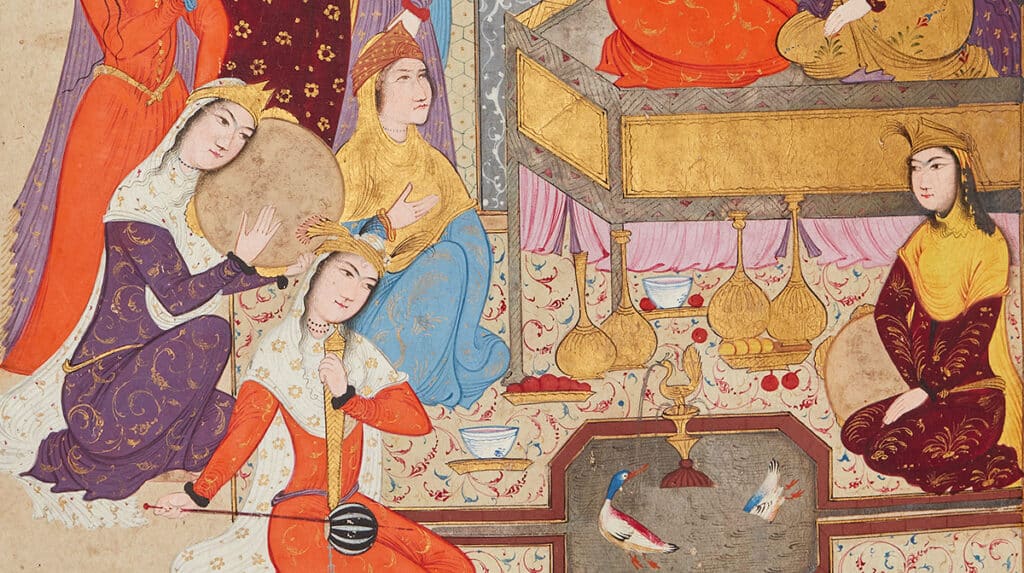
Nowruz has consistently been celebrated in various historical periods of Iran, but after the Islamic conquest, it gained particular prominence during the Safavid dynasty, especially in the middle Safavid period, where it became a stronger national and royal symbol. However, later on, with the influence of Shiite clerics at the court, the significance of national symbols decreased, and the clerics dominated these symbols.

During the Qajar Period
The Qajar court made special preparations for the grand celebration of Nowruz. The primary ceremony was called “Nowruz Salam,” which was conducted in three parts: Public Reception, Marble Throne Greeting, and the Special Gate Greeting.
A day before the festival, invitations were sent out by the head of royal ceremonies, Ali Khan Zahir al-Dawla, the Shah’s son-in-law, for various social classes. Invitees had to arrive an hour before the ceremony. The public Nowruz greeting was held at the Marble Throne located in Golestan Palace.
In Modern Times
After the 1979 Iranian Revolution, some Shiite clerics spoke against Nowruz and its traditions. Still, when they realized the deep-rooted attachment of the people to this festival, they backed down.
Before the dissolution of the Soviet Union, Iran was the only country in the world that recognized Nowruz as a national holiday in its calendar, although Afghanistan also intermittently celebrated it. However, with the independence of Central Asian countries, first the Kyrgyz Republic and Azerbaijan, followed by other nations, declared Nowruz as their national holiday. Nowruz, as a cultural heritage and national celebration, has always been observed in modern times in Iran and is celebrated annually. However, the celebration of Nowruz was banned for some time in certain countries.
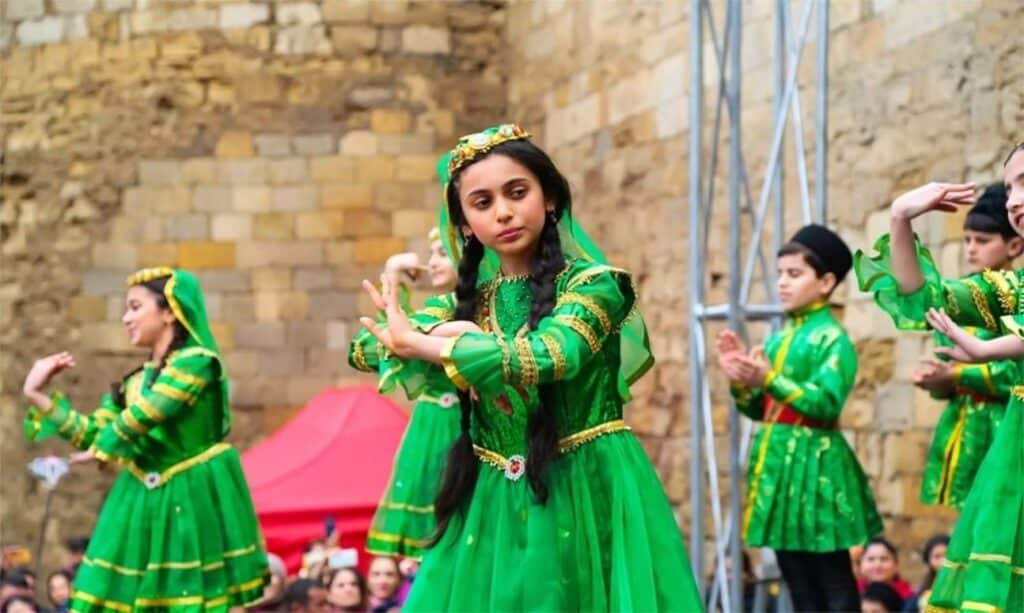
The Soviet government prohibited Nowruz celebrations in some Central Asian countries like Turkmenistan, Kyrgyzstan, and Tajikistan, and this ban continued until the time of Mikhail Gorbachev. Nevertheless, people in these regions covertly celebrated Nowruz or did so in rural areas. Some also renamed the celebration to gain local authorities’ approval.
For instance, in Tajikistan, people referred to it as “Tulip Festival” or the March 8 celebration. In Afghanistan, under Taliban rule, Nowruz celebrations were banned, recognizing only the lunar Hijri calendar. Before the year 2000 AD, Nowruz in Turkey (celebrated by Kurds) was illegal, and often its celebration was met with the arrest of Kurds by Turkish security forces. In 1992, at least 70 Kurds were killed in clashes with Turkish security forces. Although today the Turkish government celebrates Nowruz as the Turkish Spring Festival (“Nevruz” in Turkish), it still stands as a powerful symbol of the Kurdish identity in Turkey. In recent years, Nowruz has truly become global. The United Nations General Assembly in 2010 declared March 21st, equivalent to the first of Farvardin, as International Nowruz Day.

Based on the proposal from the Republic of Azerbaijan, the United Nations General Assembly recognized Nowruz, with its Iranian roots, in its calendar. In the text adopted on February 23, 2010, by the UN General Assembly, Nowruz is described as an Iranian-rooted festival on March 21 that has a history of over 3,000 years and is celebrated by more than 300 million people today.
Before this, on October 8, 2009 (in the Persian calendar), Nowruz had been registered as a spiritual heritage by the United Nations Educational, Scientific, and Cultural Organization (UNESCO) at the suggestion of Uzbekistan. The first global Nowruz celebration took place in Tehran on March 27, 2010, and this city was recognized as the “Secretariat of Nowruz”.
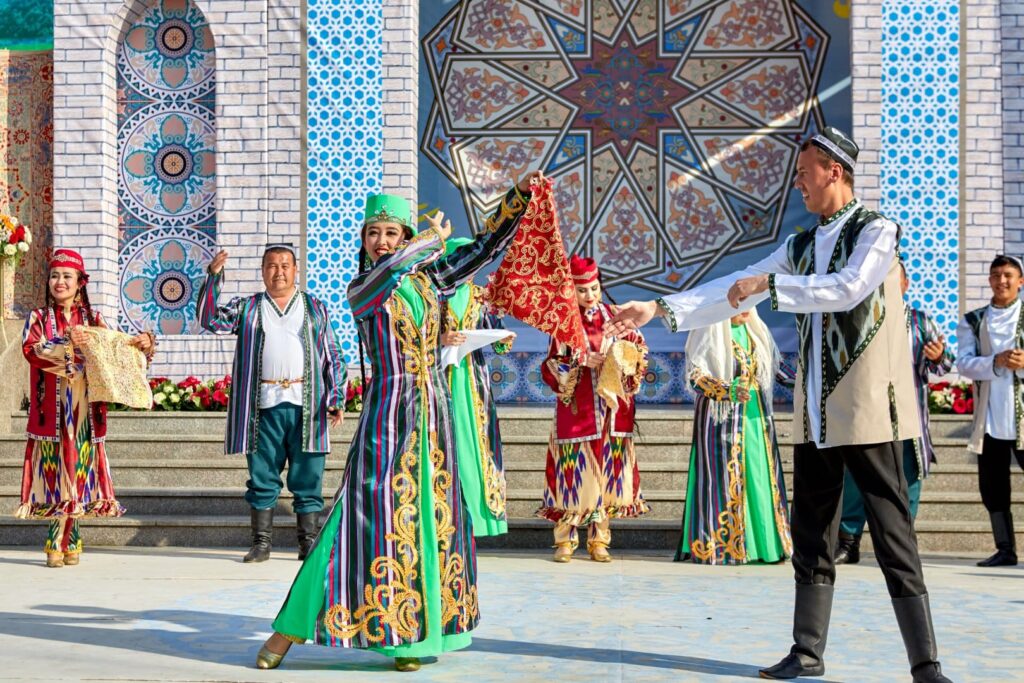
The United Nations General Assembly, by adopting a resolution, acknowledged March 21 (corresponding to the first day of the Persian calendar) under Article 49 as the “International Day of Nowruz” within the framework of a culture of peace. With this act, which was the first of its kind in the history of the organization, the Iranian Nowruz was officially recognized as an international event. For the first time, Nowruz in 2012 was celebrated at the UN and UNESCO venues hosted by Iran. Ban Ki-moon, the Secretary-General of the UN, also issued a message on this occasion.
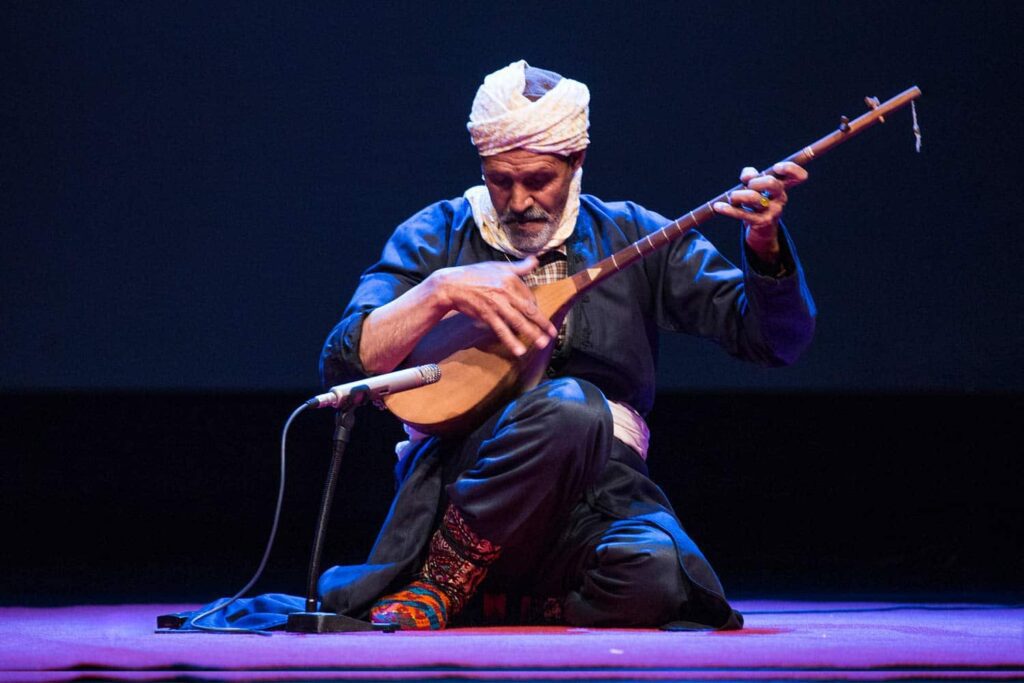
The Top 39 Nowruz (Norooz) Songs You Need to Hear
A list of the top Nowruz songs that you need to hear. These timeless tunes have been enjoyed by generations of Iranians and continue to be popular to this day.
Geography of Nowruz
The region where the Nowruz celebration takes place currently encompasses several countries and continues to be celebrated in these nations. Some Nowruz customs vary among these countries. For example, in Afghanistan, they set up a table with seven fruits, but in Iran, they set up a table with seven items starting with the Persian letter ‘S’. The Nowruz customs in the Republic of Azerbaijan are more similar to those of Iran than to other countries.
The geography of Nowruz, with the name Nowruz or its equivalents, spans across the Middle East, the Balkans, Kazakhstan, Tatarstan, Western China (Xinjiang), Sudan, Zanzibar, throughout the Caucasus to Astrakhan, and also North America, India, Pakistan, Bangladesh, Bhutan, Nepal, and Tibet.

The Kurds also celebrate this festival between March 18 and 21. For the Kurds, the uprising of Kaveh the Blacksmith and his victory over Zahhak is known as the Nowruz festival. During Nowruz, the Kurds gather outside cities to welcome spring. In these Nowruz gatherings, Kurdish women wear colorful clothes and place sparkly scarves on their heads; young Kurdish men hoist green, yellow, and red flags and dance around the fire to honor and keep Nowruz alive.
Nowruz is also common among the Arabs in southern Iraq, and on Nowruz day, they visit green fields and lush areas. In particular, visiting the Ivān i Madāyen (arched palace) on this day is among the programs of the Arabs in the south and east of Iraq. On March 30, 2009, the Federal Parliament of Canada designated the first day of spring each year as Nowruz (Nowruz Day), a national holiday for Iranians and many other ethnicities.
On February 24, 2010, the United Nations, by adopting a resolution at its headquarters, officially recognized Nowruz as the International Day of Nowruz and a culture of peace in the world.
Nowruz Outside the Nowruz Geographical Region
Iranians outside of Iran, especially in Europe, America, and Canada, have been organizing Nowruz celebrations, including the Chaharshanbe Suri (Wednesday Feast) festival, collectively for several decades.

Since the era of [President] Bush, American presidents have sent Nowruz messages to Iranians every year. On Chaharshanbe Suri of 1393 (2014 in the Gregorian calendar), Michelle Obama spoke for the first time during a Nowruz celebration at the White House. Barack Obama, in his message, said:
“This celebration was in honor of diverse cultures, food, music, and the friendship of immigrant communities that offer extraordinary services every day in the United States. As you gather around the Haft Seen table, be grateful for the blessings you have from Tehran to Shiraz to Tabriz, from the shores of the Caspian Sea to the coasts of the Persian Gulf, and look forward to the future.
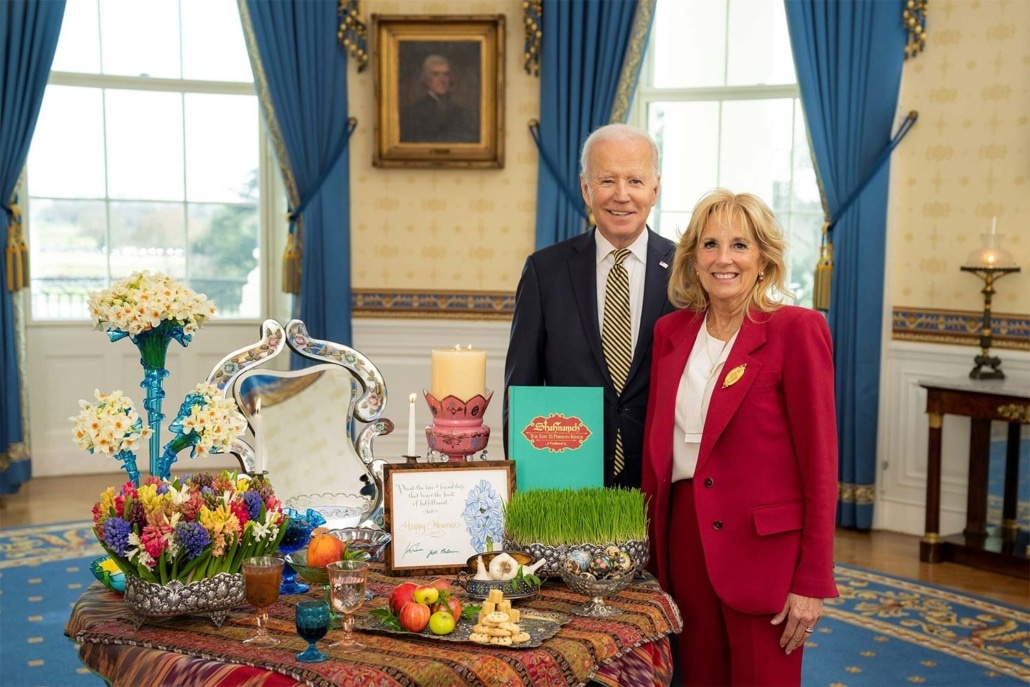
World Nowruz (Norooz) Festival
On 7th Farvardin 1389 (27th March 2010), the first edition of the World Nowruz Festival was held in Tehran, and this city was recognized as the “Nowruz Secretariat”. In this celebration, the leaders of countries that celebrate Nowruz come together to honor this ancient tradition. Every year, one of these countries hosts the World Nowruz Festival.
Nowruz Holidays
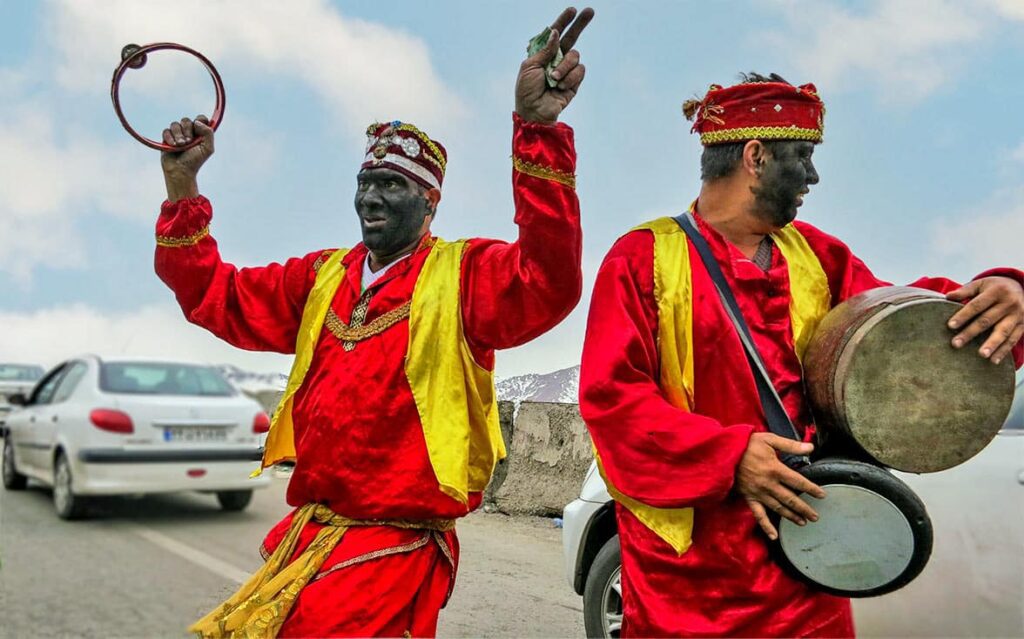
In Iran, the first four days of Farvardin, which coincide with the beginning of Nowruz, are official holidays. For schools, this holiday continues until the thirteenth day of Nowruz (Sizdah Bedar).
Nowruz (Norooz) Rituals
Nowruz (Norooz) is a collection of celebrations and events. The New Year celebrations or Nowruz festivities in Iran involve various programs, starting with Chaharshanbe Suri (Wednesday Feast).
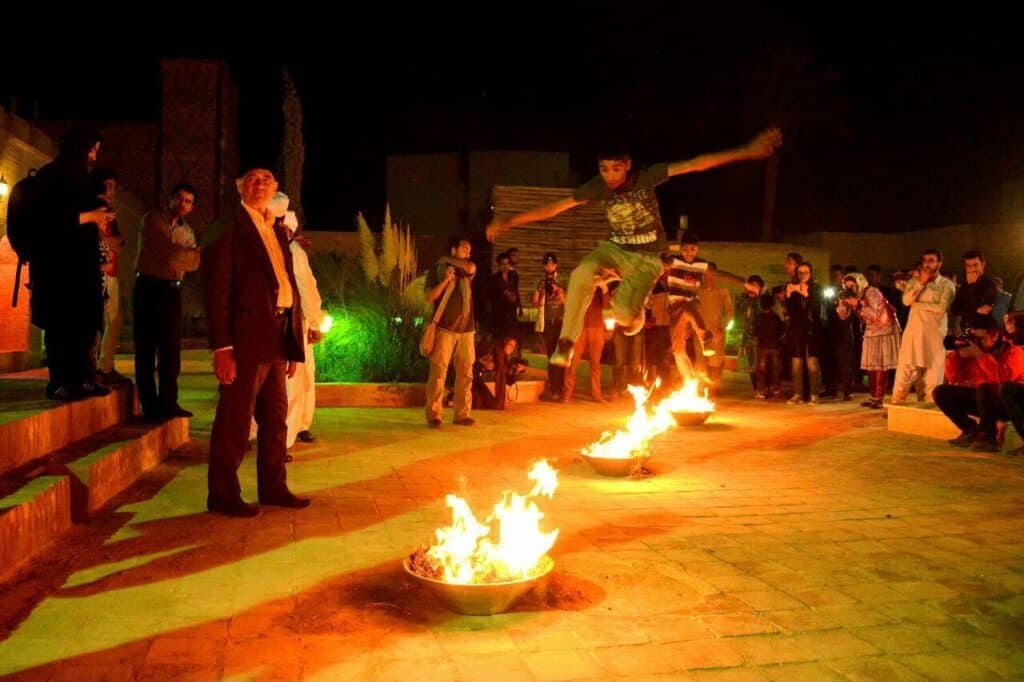
After the Chaharshanbe Suri celebration, the last Thursday involves visiting the graves and resting places of the recently deceased. The third program, more common in southern Khorasan, is the “Alfeh” ceremony.
This ritual is also held in cemeteries, graveyards, or mosques, primarily to honor and respect the deceased. In this ceremony, local sweets and cakes (Qottab, Nan-e Shiri, Goak) are placed on a spread along with sprouts.
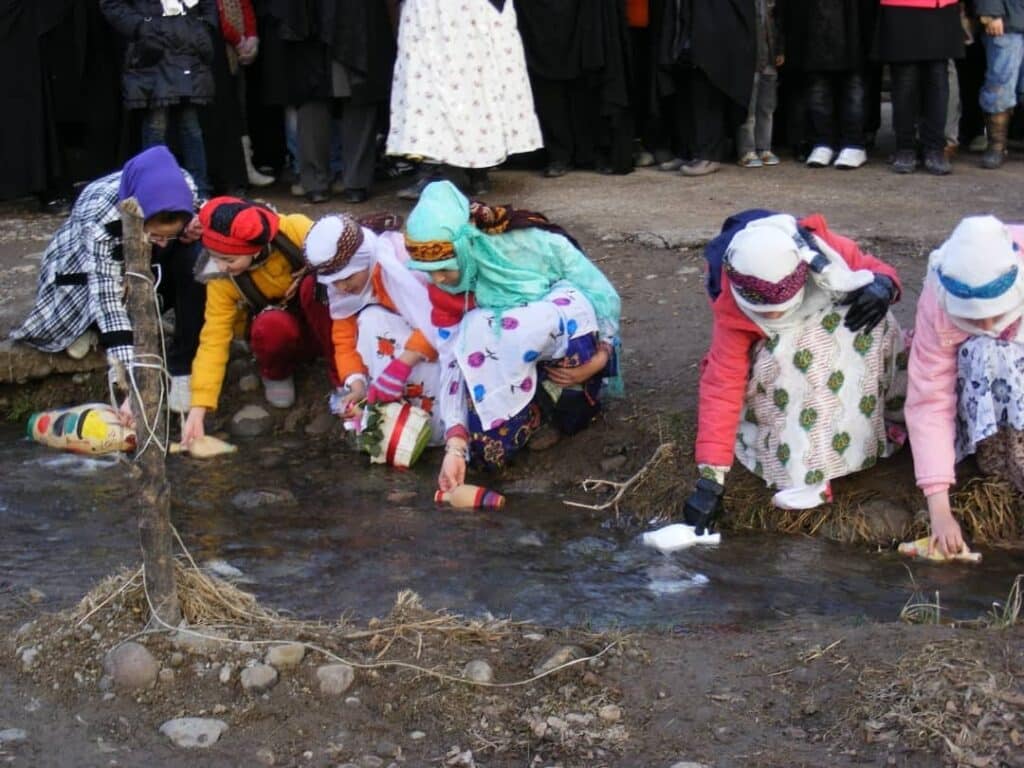
House Cleaning (Khaneh-Tekani)
Khaneh-Tekani is one of the Nowruz rituals, practiced by people in regions that celebrate Nowruz. In this ritual, the entire house and its contents are cleaned and washed in anticipation of Nowruz. This tradition is held in various countries including Iran, Tajikistan, and Afghanistan.
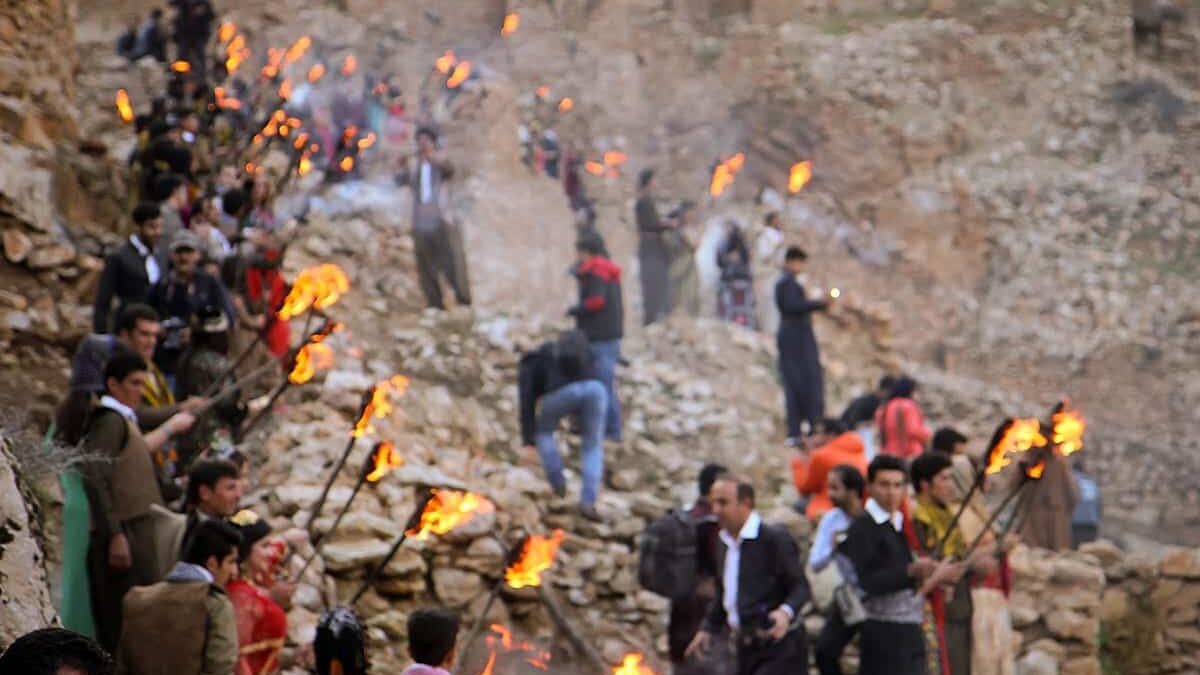
Igniting Fire
The Nowruz (Norooz) celebration in the village of Palangan is conducted by young people moving torches and ascending the cliffs behind the village. During this celebration, villagers gather on the rooftops and, accompanied by Kurdish music and wearing colorful and festive clothing, welcome Nowruz.
The custom of igniting fire has been common since ancient times in regions fond of Nowruz. In Iran, the Republic of Azerbaijan, and parts of Afghanistan, this custom is observed as lighting fires on the evening of the last Wednesday of the year, a celebration known as Chaharshanbe Suri. In Kurdistan, on Nowruz day, the Nowruz fire ceremony (in Kurdish: Agir Newrozî) takes place. Jumping over fire during Nowruz is also common in Turkmenistan.
Additionally, the custom of lighting fires on the dawn of Nowruz on rooftops is practiced among some Zoroastrians, including in some villages of Yazd in Iran.
Nowruz (Norooz) Spreads
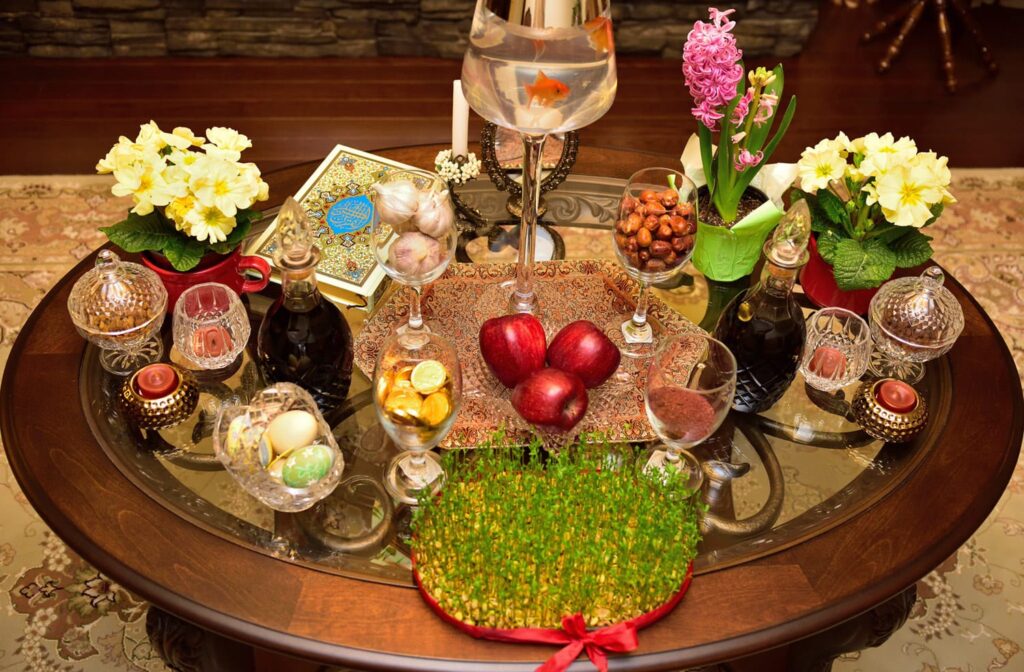
The “Sofreh Haft-Seen” is a Nowruz (Norooz) spread common in Iran, the Republic of Azerbaijan, and some parts of Afghanistan. Nowruz spreads are a shared tradition among people who celebrate Nowruz. The Nowruz spread, which is nowadays referred to as “Sofreh Haft-Seen” in Iran, consists of two types of items:
- Items with symbolic significance, such as garlic and coins.
- Items and objects meant for consumption and hospitality, such as various nuts and traditional or modern sweets.
In many parts of Iran, the Republic of Azerbaijan, and some areas of Afghanistan, the “Sofreh Haft-Seen” is laid out. On this spread, seven items beginning with the Persian letter ‘س’ (Seen) are placed, such as garlic (Seer), jujube (Senjed), wheat germ pudding (Samanu), apple (Seeb), and so on.
Special meanings are attributed to the items on the Haft-Seen; for instance, apples symbolize beauty and health, jujubes represent love and affection, and coins signify prosperity and wealth.
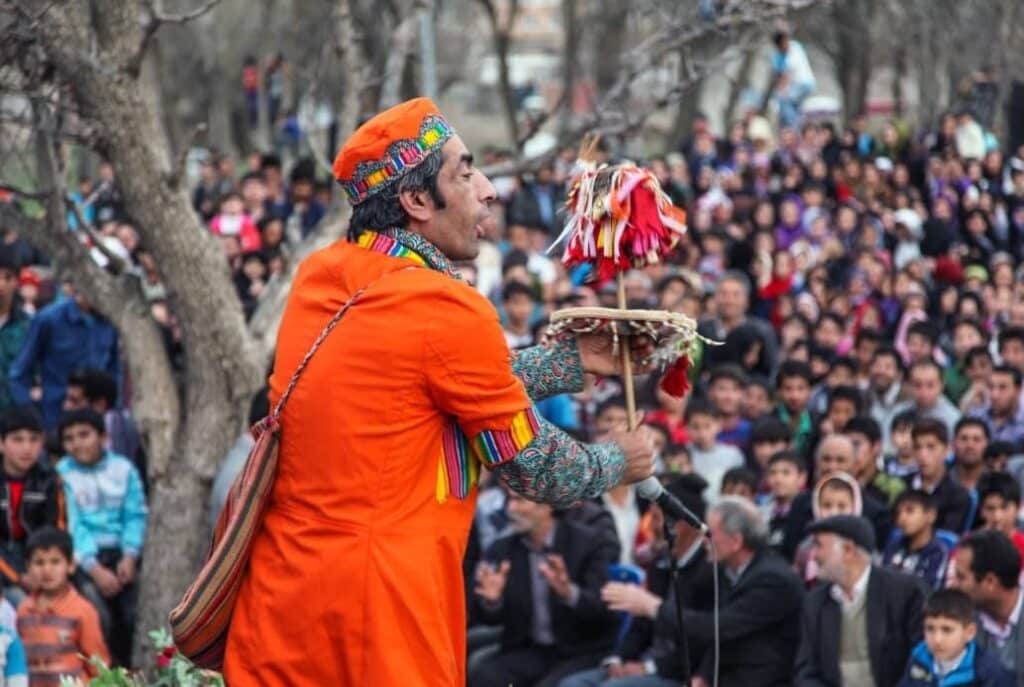
The Nowruz spread has ancient roots, but it traditionally involved laying out a cloth and placing various dried fruits in clay or metal dishes, such as dried mulberries, dried apricot leaves, dried peaches and plums, dried and cooked loquats, dried milk whey, cookies, Qottab, Sar-Mouki bread, etc.
Colored eggs were a mainstay of these spreads. Some items on the spread, like the eggs and mirror, had only aesthetic and symbolic significance. However, most other items were for consumption and hosting guests. Whenever something ran out, the homeowner would immediately replenish it for new guests.
Chaharshanbe Suri and Sizdeh Bedar
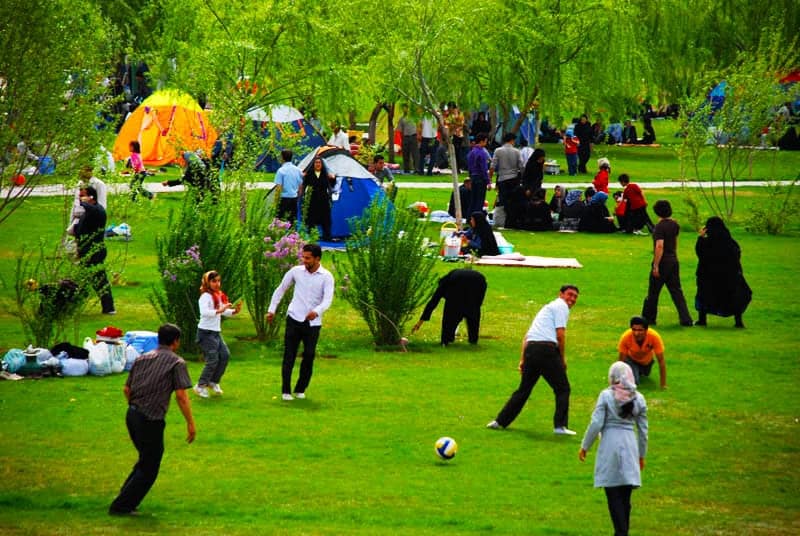
The tradition of having seven items starting with the letter “س” (Seen) on the Nowruz (Norooz) spread is a relatively new phenomenon, without historical documentation.
Of course, the Nowruz spread has always had its symbols and meanings, but it seems that the custom of placing seven items starting with “س” (Seen) on the spread became popular towards the end of the Qajar era, without any historical background, and was widely propagated by the media.
One of the essentials of Nowruz has been wearing new clothes and taking a bath. Men and women would visit public baths, either male or female baths, before the arrival of Nowruz.
The busiest days at these baths were during the first few days of the New Year. In the old bathhouses, where water was typically heated with wood and kindling in the “Gor Khaneh” or the furnace room, it was necessary for the bathhouse attendants to store special reserves of wood and kindling for Nowruz.
Setting up the Nowruz spread in Iran has its own special customs, with other elements such as a mirror, candles, and water also present.
Other components of the modern spread include fish and colored eggs. In Kabul and northern cities of Afghanistan, the “Seven Fruits” spread is common. This spread contains seven fruits including green and red raisins, walnuts, almonds, pistachios, apricots, and oleaster. A similar spread using dried fruits is also customary among the Shia Muslims of Pakistan.
Additionally, the “Seven Shin” spread is popular among Zoroastrians, and the “Seven Mim” spread is common in some parts of Fars province in Iran.
In the Republic of Azerbaijan, the number seven doesn’t hold particular significance, and their Nowruz spread typically contains a mix of nuts.
Nowruz Dishes
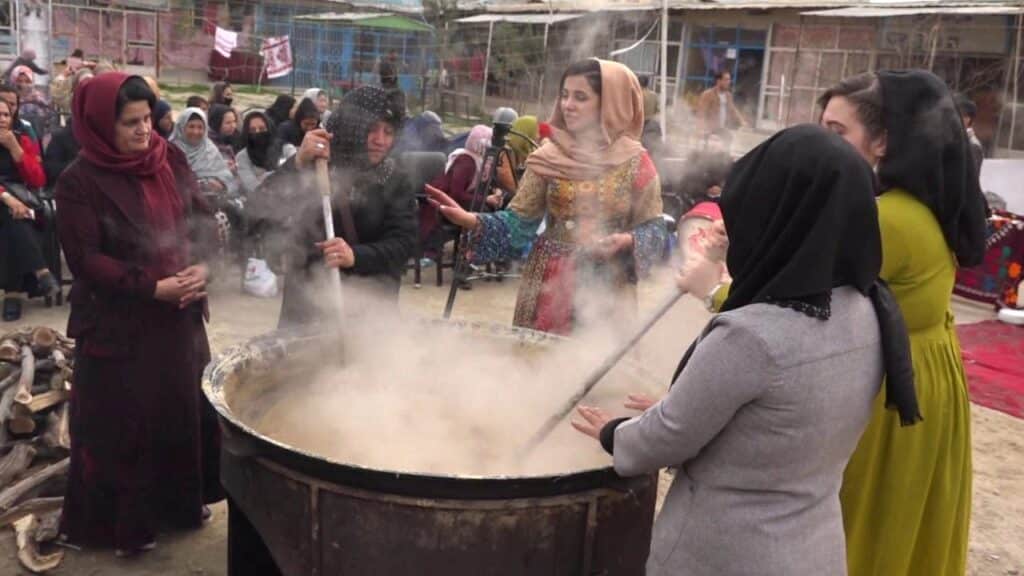
One of the most common dishes prepared for Nowruz (Norooz) is “Samanu” (also known as Samank, Soumenk, Soumlak, Samani, or Samaneh). This dish is made using sprouted wheat. In most countries that celebrate Nowruz, this dish is cooked. In some countries, cooking this dish is accompanied by special rituals.
Women and girls in various regions of Iran, Afghanistan, Tajikistan, Turkmenistan, and Uzbekistan prepare Samanu collectively, often throughout the night, singing special songs while cooking.
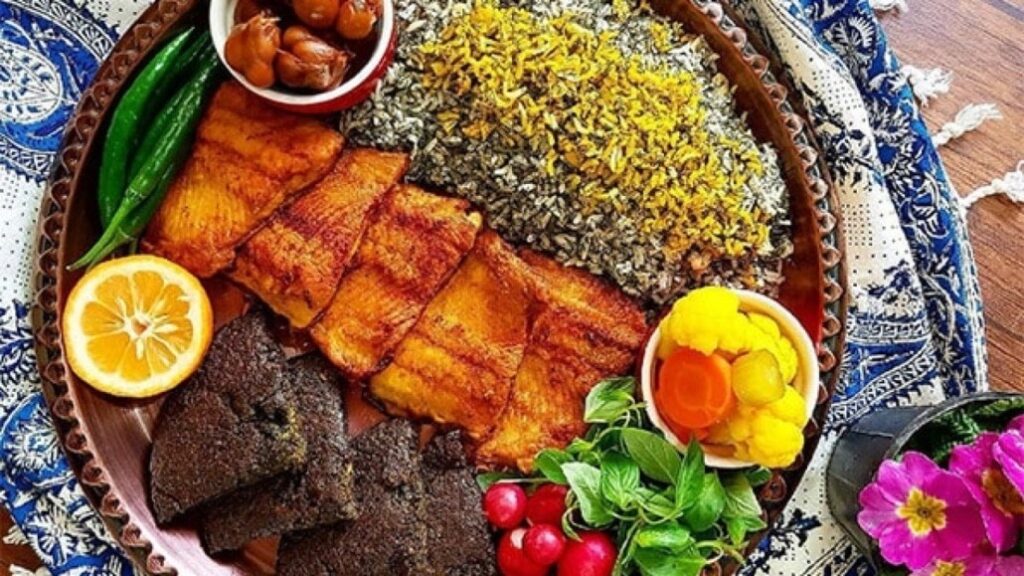
Cooking other dishes during Nowruz (Norooz) is also customary. For instance, “Sabzi Polo” with fish is consumed on the eve of the festival, along with sweets like chickpea cookies.
In Afghanistan, they have “Sabzi Chelo” with fish; in Tajikistan, they prepare “Baj”; in Turkmenistan, it’s “Nowruzbameh”; in Kazakhstan, they cook “Oviqi Ashar”, and in Bukhara, various types of “Sambusa” are prepared. Generally, cooking Nowruz dishes is customary in any region celebrating the holiday, with each region boasting its unique dishes and sweets.
Visiting and Hosting in Norooz
“Did o Bazdid” or “Eid Visiting” is a Nowruz (Norooz) tradition commonly practiced in most countries that celebrate it. In some regions, remembering the deceased and visiting their graves during Nowruz is also customary. Nowruz day usually starts with visits to relatives and kin.
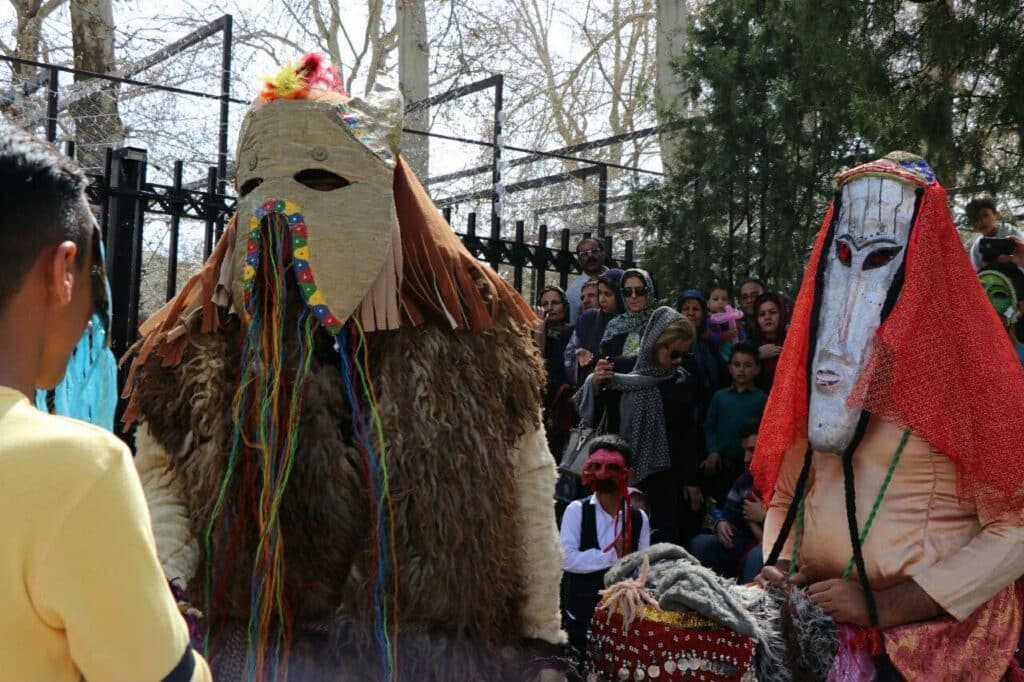
New and Clean Nowruz Attire
Taking a bath and wearing new clothes are essentials of Nowruz day. People were expected to visit their relatives and friends dressed in new and clean attire. In the past, the traditional attire in each region of Iran was distinct. Especially, each tribe or nomadic group might have had a different type of hat.
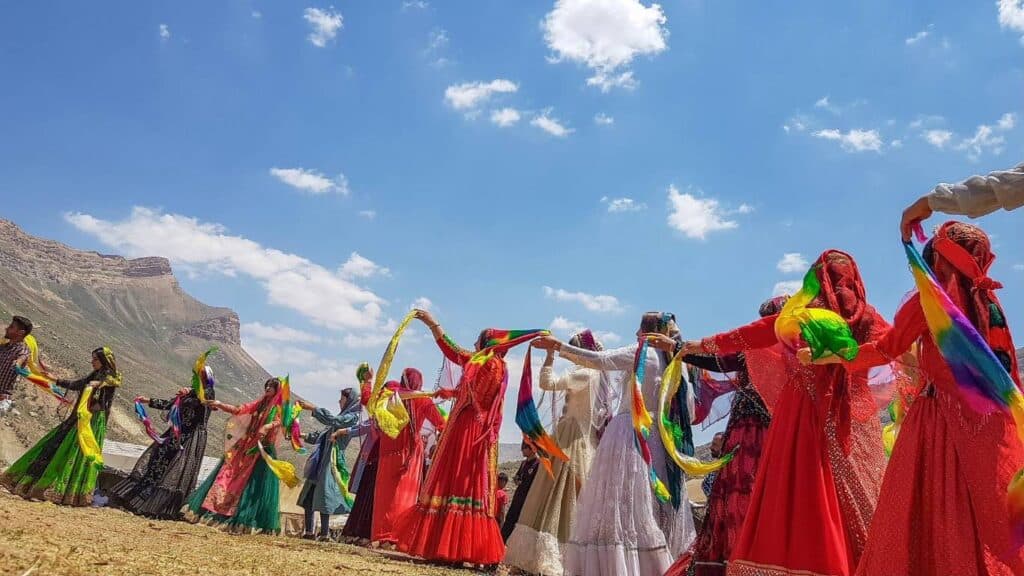
Wearing traditional outfits during Nowruz was typical in most areas of Iran, and in most regions, men draped a type of cloak, similar to an ‘aba, over their shoulders.
Nowadays, the President of Afghanistan uses this cloak for official ceremonies. From the time of Reza Shah, various tribal attire, which sometimes carried signs of prestige, was replaced with a nationwide standardized suit and tie and a western hat.
Tourism

In Iran, Nowruz holidays are usually accompanied by a high volume of tourist trips. The statistics of these trips have been on the rise in recent years.
Sports Competitions in Norooz
Organizing public sports competitions in urban and rural streets is another ritual held in some countries on the occasion of Nowruz (Norooz).
In Turkmenistan, Turkmen men and women organize special games and entertainments, including horse riding, wrestling, jumping to catch a handkerchief from a height, and chess. Holding cockfights and ram headbutting are also ceremonies that take place in Turkmenistan.
In the northern provinces of Afghanistan, goat-pulling competitions are also held on various occasions, including Nowruz.
Nature Outings
People in Iran on the 13th of Farvardin (which corresponds to early April in the Gregorian calendar) head to natural places like parks, gardens, forests, and areas outside cities.
This event is called “Sizdah Be-dar”. A common activity during this celebration is knotting sprouts (Sabzeh). The Sizdah Be-dar ceremony is also held in western regions of Afghanistan, including the city of Herat.
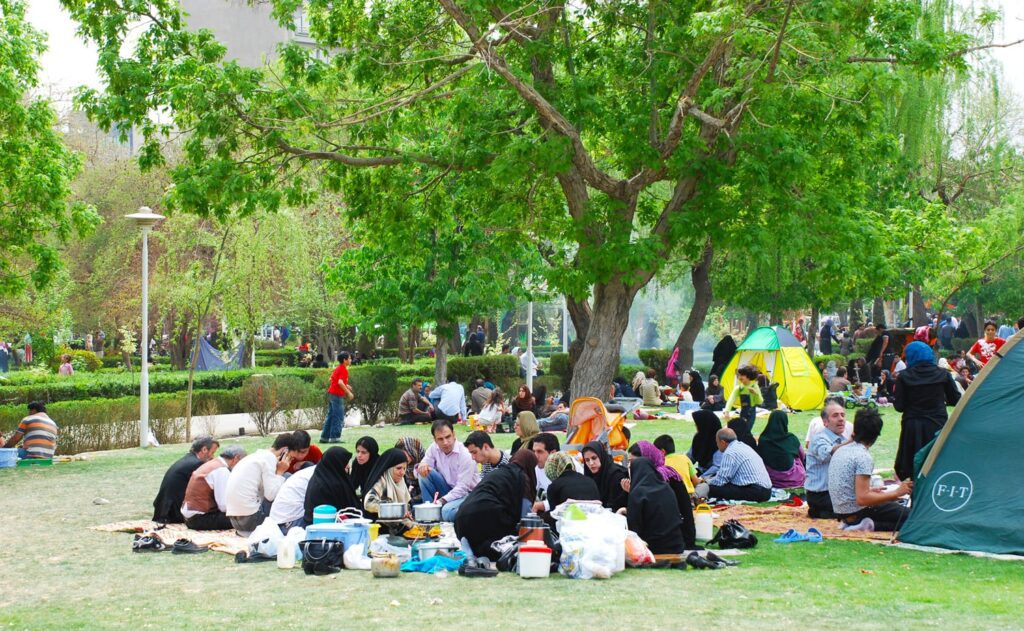
Although the 13th of Farvardin is not an official holiday in Afghanistan, people in these regions effectively close their businesses to enjoy nature.
They also spend the first Thursday of the year exploring the outdoors. Furthermore, residents of Kabul, during the first two weeks of the new year, visit areas where the Judas tree (redbud) flowers bloom.
Another Nowruz (Norooz) ritual common in Central Asia and Tajikistan is the “flower turning” and “nightingale singing” ceremony. People gather flowers from valleys, hills, and mountain slopes, then notify their villagers about the end of winter, the coming of spring, the start of spring farming, and the arrival of Nowruz.
Nowruz Singing
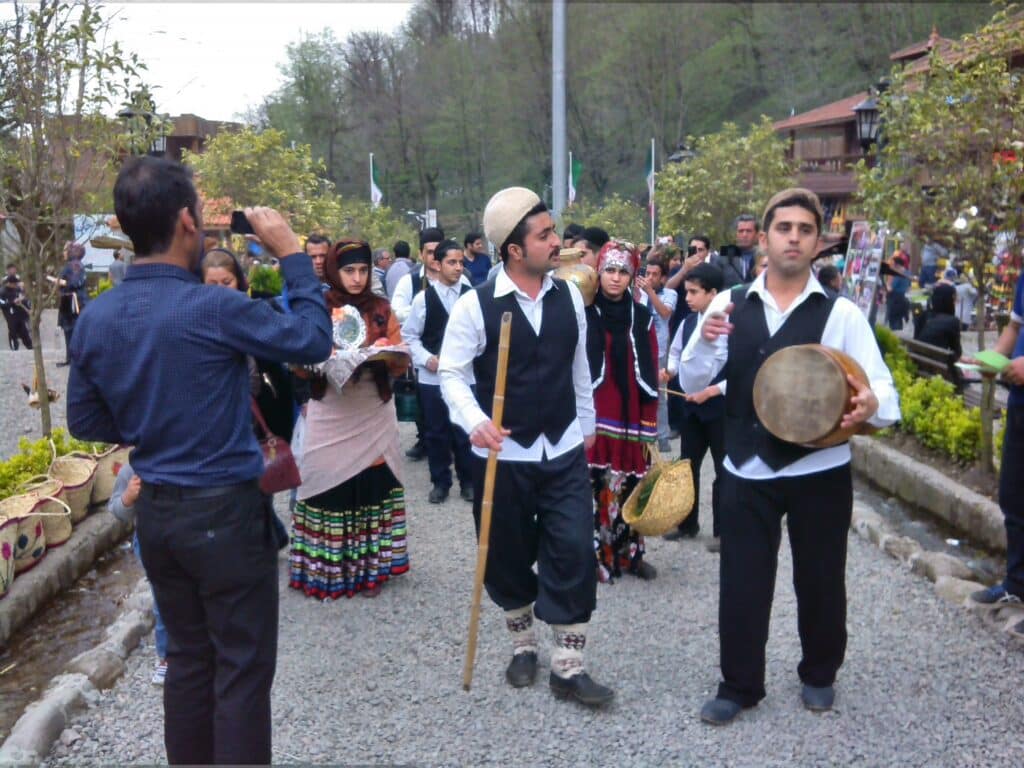
Nowruz singing, also known as Bahar Khani or Noroozi, is a type of singing that was popular in the past in Iran. Currently, this singing style is more prevalent in the provinces of Mazandaran and Gilan.
In Nowruz singing, individuals called “Nowruz singers” travel to different cities and villages before the start of spring, singing poems in praise of spring or with religious themes, either improvised or from memory. These poems are mainly in Tabari and Gilaki languages.
Most of these poems are written in a quatrain format and are sung by one or more individuals simultaneously.
Nowruz Songs
When it comes to music, there is no shortage of amazing Nowruz songs to choose from. here, we’ve compiled a list of the top Nowruz songs you need to hear.
1. Boye Eydi — Farhad Mehrdad
2. Nobahar — Andy, Sattar, Morteza, Vigen, Leila Forouhar, Kouros, Fataneh, Aref & Delaram
3. Amad Nobahar — Delkash
4. Gol Umad Bahar Umad — Pooran
5. Smell of Norooz — Iraj Bastaami
6. Booye Baroon — MohammadReza Shajarian
7. Jashne Golha — Marzieh
8. Be Raghs Aa — Mohsen Chavoshi
9. Jashne Golha — Marzieh
10. Noroz — Sima Bina
11. Norouz Amad — Hayedeh
12. Nowrooz — Alireza Ghorbani
13. Samanoo Foroosh — Mohammad Montasheri
14. Shokoufeha — Viguen
15. Bahar — Ziba Shirazi
16. Bahar — Martik
17. Bahar Bahar — Hayedeh
18. Bahare Delkash — Mohammadreza Shajarian
19. Norouz — Homayoun Shajarian
20. Agar Bahar Biayad — Ahmad Zahir
21. Norooz Khani — Ajam
22. Bayram Mobarak — Ajam Band
23. Norouz Too Rahe — Ali Azimi
24. Gardeshe Farvardin — Ali Zand Vakili
25. Eydaneh — Alireza Assar
26. Mazandaran Nowruz Khani — Ebad Mohammadi and Jalal Mohammadi
27. An Shabe Bahar — Fahime Akbar
28. Naghme–ye Nowruzi — Gholamhossein Banan
29. Vals Norouzi — Hooniak Band
30. Hossein Lashgari – Khorasan Nowruz Khani — Hossein Lashgari
31. Parivash — Jamshid Sheybani
32. Mano To Derakht o Baroon — Khashayar Etemadi
33. Bahar Bahar — Naser Abdollahi
34. Reshid Behbudov – Bahare Delkash — Reshid Behbudov
35. Norooz Too Rahe — Samin Baghcheban
36. Ey Bahar-e Man — Sepideh Raissadat
37. Uraman Nowruz Khani — Shafi Khalidi and Adel Khalidi
38. Nasim Bahari — Abdolvahab Shahidi
39. Valse Noroozi — Ahmad Ashoorpour
Listen on Spotify
Attempts to Erase Nowruz in Afghanistan
The presence of the Taliban severely threatens the shared cultural heritage of Iran and Afghanistan, including the Persian language and literature, rituals like Nowruz, ancient sites, and more. During their first rule in the 1990s, the Taliban declared any kind of Nowruz celebration an imitation of Iranians and deemed it an innovation (Bid’ah) and forbidden (Haram).
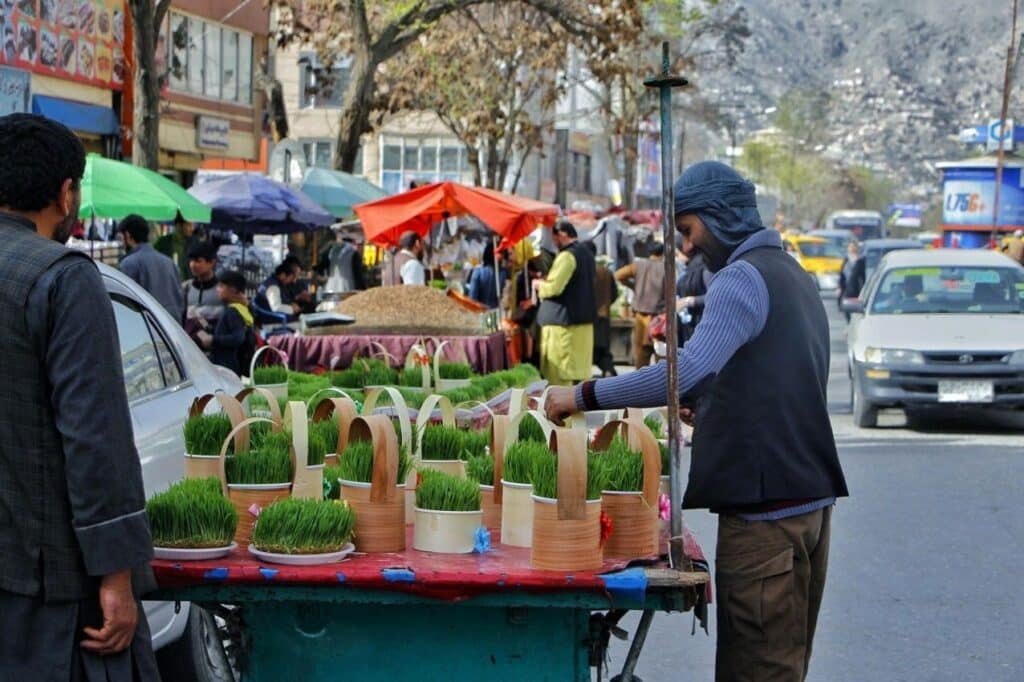
The Taliban harshly confronted the celebrants, even replacing the solar calendar with the lunar one. Nevertheless, during those times, some people still celebrated Nowruz in various regions (primarily non-Pashtun areas), including Mazar-i-Sharif and Kabul. Even in central regions (predominantly Shia-inhabited), celebrating Nowruz and the parade named “Kampirak” was considered a public opposition to the strict governance of the Taliban.
Conclusion
As we reflect on the vibrant celebration of Nowruz (Norooz), it’s clear that this ancient festival, deeply rooted in Iranian culture, resonates far beyond the borders of Iran. Celebrated by millions across Asia and other parts of the world, Nowruz symbolizes not just the arrival of spring but also the spirit of renewal and unity. Occurring at the vernal equinox, it marks a time of balance and new beginnings. Whether you’re in Iran experiencing the rich traditions firsthand, or celebrating in another part of the world, Nowruz connects us all in its universal message of hope and rebirth.
Read More
